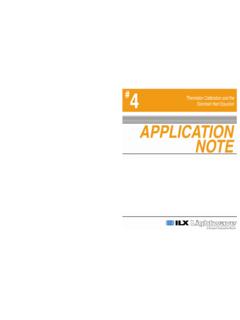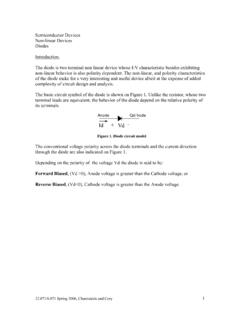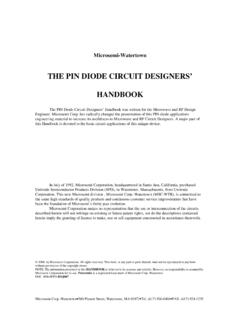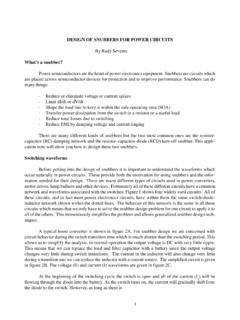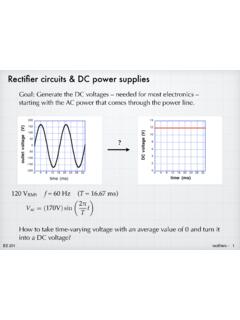Transcription of An Overview of Laser Diode Characteristics - Newport
1 For application assistance or additional information on our products or services you can contact us at: ILX Lightwave Corporation 31950 Frontage Road, Bozeman, MT 59715 Phone: 406-556-2481 800-459-9459 Fax: 406-586-9405 Email: To obtain contact information for our international distributors and product repair centers or for fast access to product information, technical support, LabVIEW drivers, and our comprehensive library of technical and application information, visit our website at: Copyright 2005 ILX Lightwave Corporation, All Rights Reserved #5 An Overview of Laser Diode Characteristics1 Diode lasers have been called wonderful little devices.
2 They are small and effi cient. They can be directly modulated and tuned. These devices affect us daily with better clarity in our telephone system, higher fi delity in the music we play at home, and a host of other, less obvious ways. But Diode lasers can be frustrating to work with. The same family of Characteristics that permit wide areas of application also make Diode lasers diffi cult to OverviewLaser Diode characterization can be broken down into fi ve categories, as shown in Table article presents a general look at the electrical, spatial, and spectral Characteristics of Diode lasers. The optical category of Table 1 generally falls into the realm of interferom-etry, while the dynamic category of Table 1 represents an involved and highly interactive Measuring Diode Laser CharacteristicsDiode Lasers Approach Ubiquity, But They Still Can Be Frustrating To Work With By Tyll Hertsensattempt at real-time equivalent- circuit mod-eling, mostly during device modulation.
3 The last two categories of Table 1 represent topics of other articles, for other CharacteristicsThe L/I Curve. The most common of the Diode Laser Characteristics is the L/I curve (Figure 1). It plots the drive current applied to the Laser against the output light intensity. This curve is used to determine the Laser s operating point (drive current at the rated optical power) and threshold current (current at which lasing begins).As can be seen in Figure 1, the threshold of the Laser is strongly affected by the Laser s temperature. Typically, Laser threshold will increase exponentially with temperature as Ith exp(T/To), where T is the Laser temperature in degrees Kelvin and To is the characteristic temperature of the Laser (typically 60 to 150 K).
4 Figure 1. The continuous wave L/I suggest poor die attachment or a leaky junction, and are often an indicator of poor Laser Ratio. Many Diode Laser packages include a back-facet monitor photodiode that detects the intensity of the light exiting the rear facet of the Laser cavity. Normally, the signal current from this photodiode is used as a feed-back source for the Laser drive circuits, for output power stabilization of the Diode Laser . The monitor photodiode is most commonly characterized by comparing its output current against the light output from the Diode Laser . Since the monitor photodiode current is directly proportional to the output light, the tracking ratio is a single number and is measured in mA/mW.
5 An unusual application of this measurement occurs when characterizing Diode lasers coupled directly to optical fi bers. In this case, tracking ratio is a comparison of light output from the fi ber with the monitor photodiode current. Tracking ratio changes with temperature and drive current, indicating changes in coupling effi ciency between the Laser s output facet and the input end of the fi ber. Such fl uctuations of tracking ratio can be The effi ciency of a Diode Laser is also derived from the L/I curve. It is most commonly expressed as slope effi ciency and measured in units of mW/mA. Although not as apparent as threshold shift, Laser effi ciency also falls off with increasing temperature (Figure 2).
6 Laser effi ciencies are typically about mW/mA at 25 C, and drop about mW/mA for every 10 C increase in L/I Curve. The L/I Characteristics may also be acquired in a low-duty-cycle pulsed mode. The increase in threshold and decrease in slope effi ciency observed in the continuous wave data, as compared to the pulsed data (Figure 3), stems from the rise in junction temperature. This rise, due to the thermal resistance of the device, is typically 40 to 80 C/W. Typically, pulse widths used in this type of measurement are 100 to 500 nanoseconds, with a duty cycle of less than one large differences between the continuous wave and pulsed L/I curves Threshold current (mA)Temperature ( C) (W/A)Figure 2.
7 Threshold current rises and effi ciency falls as the temperature 3. The pulsed L/I to detect mechanical instabilities in the fi ber mounting or changes in the near-fi eld emission pattern of the V/I Curve. The voltage drop across the Laser is often acquired during electrical characterization. This characteristic is similar to the analogous characteristic of any other type of semiconductor Diode and is largely invariant with temperature, as depicted in Figure 4. (Note: Diode Laser manufacturers usually place the forward voltage on the X axis, in compliance with conventional practice in the electronics industry for other types of diodes. Companies manufacturing instrumentation to characterize Diode lasers often present the curve in the manner of Figure 4, with the forward current on the X axis.)
8 Thus, other performance curves as will be described in later sections may be overlaid onto the V/I curve. Conventional electronics people would call this an I/V curve, rather than accept our nomenclature of a V/I curve). The typical voltage drop across a Diode Laser at operating power is volts. V/I data are most commonly used in derivative characterization note of caution. It is extremely damaging to apply a large reverse bias to a Diode Laser . Manufacturers of Diode lasers may look at the reverse bias breakdown Characteristics of the Laser to control some of the device geom-etries. Even in that limited instance, manufac-turers are careful not to exceed about 10 A of reverse is no one right way to calculate threshold current.
9 There are, however, four commonly accepted methods, as described in Table 2 and graphically depicted in Figure 5. Any of the four methods outlined in Table 2 may be successfully used, but the second derivative method seems to be most widely favored. The two-segment fi t, 1st derivative, and 2nd derivative methods are based on Telcordia GR-468-CORE and GR-3010-CORE. The linear fi t is not recognized by CharacterizationsThere are four frequently used derivative curves calculated from L/V/I data. The most commonly used derivative is the dL/dI curve. Figure 4. The V/I voltage, Vf(V)Forward current, If(mA)4 The dL/dI curve of Figure 6 plots the instantaneous slope effi ciency against drive current.
10 It is extremely sensitive to nonlinearities and is used to identify kinks in the L/I data. Once you become accustomed to viewing the relationship between the dL/dI curve and the L/I curve, you will not want to see Diode Laser data without second derivative of L/I data is the d2/dI2 curve. It is almost exclusively used in the calculation of Diode Laser threshold, as noted in Figure two remaining derivatives, the dV/dI and the IdV/ dI curves (Figure 7), are most often used for process control feedback in the Diode Laser manufacturing process. The dV/dI curve, usually called the dynamic resistance curve, is expressed in ohms and is the effective resistance to a change in current at a given current.

